Today we will discuss about Laser Scarecrows Technology in Agriculture which has become very important idea in 2013. Agriculture has always been an important sector in human civilization. With the increasing population, the demand for food is increasing every day. In order to meet the demand, farmers are using advanced technologies to increase their crop yield. One such technology is laser scarecrows, which are gaining popularity in agriculture.
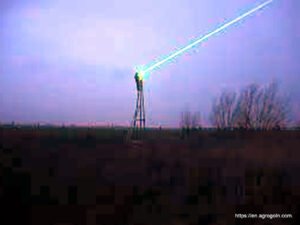
Table of Contents
Laser Scarecrows Technology in Agriculture
Laser scarecrows, or laser bird deterrent systems, are devices that utilize green laser light beams to scare away pest birds from agricultural fields. This technology hinges on birds’ perceived threat from the laser beam, causing them to flee from the area. The fundamental advantage of these systems is that they provide a humane method for deterring birds, causing no physical harm to the animals.
The operation of these systems is quite simple. They project a green laser beam that moves randomly within a defined area. Birds interpret this moving laser beam as a physical threat – like an approaching predator – and respond with an instinctive flight response, thereby clearing the field. Furthermore, laser scarecrows can operate autonomously, covering a large area without the need for human intervention.
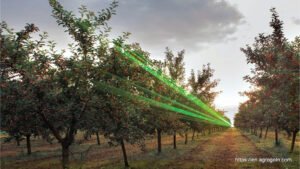
What are Laser Scarecrows?
Laser scarecrows are an innovative approach to scare birds away from crops without harming them. It is a high-tech device that emits a laser beam that creates a visual disturbance in the bird’s eye, making them think it is a predator or a threat, and scaring them away. The laser scarecrow is designed to work during the day and night, and the laser beam can be adjusted to different frequencies, colors, and patterns.
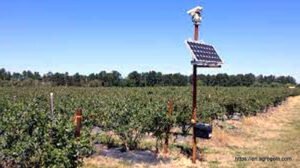
Benefits of Laser Scarecrows in Agriculture:
Increases Crop Yield:
Birds are one of the biggest threats to agriculture, as they can cause significant damage to crops. Using traditional scarecrows or bird repellents is not always effective, and sometimes, the birds get used to these methods and no longer consider them a threat. Laser scarecrows, on the other hand, are an effective solution that can keep birds away from the crops, increasing crop yield.
Environmentally Friendly:
Laser scarecrows are environmentally friendly as they do not use any chemicals or harmful substances that can harm the birds, the crops, or the environment. The laser beam is harmless to the birds, and it only creates a visual disturbance that scares them away. Laser scarecrows do not harm other wildlife or insects, which is essential for maintaining a balanced ecosystem.
Cost-Effective:
Although the initial investment in laser scarecrows may seem high, it is a one-time investment that can last for years. Unlike traditional scarecrows, laser scarecrows do not need to be replaced or maintained frequently, reducing the cost of the equipment. The long-term cost savings and increased crop yield make laser scarecrows a cost-effective solution for farmers.
Easy to Install and Use:
Laser scarecrows are easy to install and use, and they require minimal maintenance. Once installed, the device can be left to do its job, without any need for human intervention. Farmers can control the laser scarecrow through a remote control or an app, making it easy to adjust the frequency, color, and pattern of the laser beam.
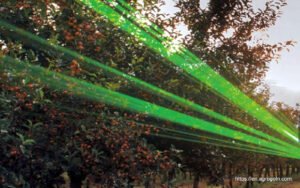
Challenges of Laser Scarecrows in Agriculture:
Weather Conditions:
Laser scarecrows may not work effectively during adverse weather conditions such as heavy rain, snow, or fog. The laser beam may not be visible in such conditions, reducing its effectiveness. However, some laser scarecrow models are designed to work in adverse weather conditions, making them a more reliable solution.
Power Source:
Laser scarecrows require a stable power source, which may not always be available in rural areas. Solar-powered laser scarecrows are an option, but they may not work effectively during cloudy days or when there is not enough sunlight. Farmers may need to invest in backup power sources such as batteries or generators to ensure the laser scarecrow works continuously.
Bird Habituation:
Bird habituation is a common problem with any bird control method. Birds may get used to the laser scarecrow over time and no longer consider it a threat, reducing its effectiveness. Farmers may need to change the frequency, color, or pattern of the laser beam to prevent bird habituation.
Laser scarecrows are a technological innovation that can help farmers protect their crops from birds, increase crop yield, and reduce the use of harmful chemicals. Although laser scarecrows have some challenges, they offer a cost-effective, environmentally friendly, and easy-to-use solution for farmers.
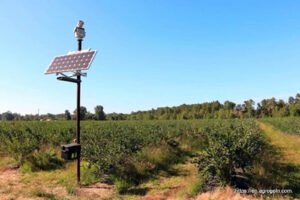
Implementation and Use Cases:
In practice, laser scarecrows have found applications across various types of farms and crops. For instance, vineyards, which often suffer from bird attacks on ripening grapes, have successfully used laser scarecrows to keep birds at bay, leading to increased yields and decreased crop damage.
In orchards and berry farms, where fruits are highly susceptible to bird pecks, these laser devices have proved effective in protecting vast crop stretches. Similarly, in aquaculture, laser scarecrows prevent seabirds from depleting fish stocks in commercial ponds.
Grain farms also stand to benefit from this technology. Every year, vast amounts of cereal crops like wheat and corn are lost to pest birds. By installing a network of laser scarecrows, farmers can protect their grain crops from being eaten or damaged, thereby safeguarding their income and food production.

Challenges and Future Perspectives
While laser scarecrows offer a promising solution for pest bird control, they are not without their challenges. For instance, initial installation costs may be high for small-scale farmers, although the long-term benefits in terms of reduced crop losses can offset these costs.
Also, as with all automated systems, there’s a risk of technical malfunctions that require maintenance and repair. This potential need for tech support could be a barrier for farmers in remote locations or those not comfortable with technology.
Nonetheless, as technological advancements continue, these hurdles are expected to diminish. For instance, advancements in solar power could eliminate the need for electrical wiring, making these systems more affordable and easier to install. Additionally, continuous software upgrades can improve reliability, effectiveness, and user-friendliness.
As precision agriculture progresses, the integration of laser scarecrows with other farm management systems, like crop monitoring drones or smart irrigation systems, could offer comprehensive, tech-driven farm management solutions.

Market Penetration of Laser Scarecrows
As the benefits of laser scarecrows become more widely recognized, their adoption in the agricultural sector is expanding. While initially more prevalent in developed countries with greater capital investment capacity and access to technology, the use of laser scarecrows is gradually penetrating markets in developing nations too.
Notably, manufacturers are targeting emerging economies, offering flexible payment options, and providing technical training to catalyze this growth. In parallel, governmental initiatives encouraging sustainable and technologically-driven farming practices further contribute to market growth.
Nevertheless, market penetration is not homogeneous worldwide. Factors such as local pest profiles, the crop species cultivated, climatic conditions, and the scale of farming operations influence the applicability and uptake of laser scarecrow technology. Moreover, the varying economic strength, technological infrastructure, and regulatory frameworks across countries shape market development.
Despite these variable dynamics, the general trend indicates an increased acceptance of laser scarecrow technology as a reliable and sustainable pest management solution.

Evolving Technology of Laser Scarecrows
Laser scarecrows, like any technological innovation, are subject to continuous refinement and advancement. Initial models were largely manual and required human effort for operation. Over time, manufacturers introduced automated devices equipped with light and motion sensors to optimize performance and user convenience.
Furthermore, contemporary laser scarecrows incorporate smart technology for precision farming. Some models offer GPS capabilities, allowing farmers to pre-set the geographic range of operation. Others offer integration with mobile applications, enabling remote control and real-time monitoring.
Recent advancements also encompass energy efficiency. To circumvent the reliance on electrical grids, newer models of laser scarecrows are solar-powered. This development not only enhances the environmental sustainability of these devices but also facilitates their use in remote areas without reliable electricity.
Future development may entail greater automation and intelligence. Machine learning algorithms could be deployed to improve the effectiveness of laser scarecrows. For instance, these algorithms could enable the devices to learn and adapt to the behavior patterns of different bird species, ensuring optimal deterrence. Also, IoT integration could enable seamless interaction with other smart devices on the farm, fostering a holistic smart farming ecosystem.

Laser Scarecrows and Environmental Considerations
A significant advantage of laser scarecrows lies in their environmental friendliness. Unlike chemical deterrents or sound devices, laser scarecrows cause no pollution. The green laser light used in these devices is harmless to both the birds and the environment. Moreover, with solar-powered models, the energy footprint of these devices is minimal.
It is also important to consider potential environmental concerns. For instance, questions have been raised regarding the impact of these devices on non-target species or their possible disruptive effect on local ecosystems. Research in this area is necessary to ensure the ecological integrity of laser scarecrow use.
Furthermore, as these devices become more common, the development of best-practice guidelines and regulatory oversight could ensure their safe, ethical, and ecologically sound application. This framework can help strike the right balance between effective pest control and preservation of natural ecosystems.
In conclusion, laser scarecrows offer a promising alternative to traditional bird deterrent methods in agriculture. Through ongoing technological enhancements, their performance, user-friendliness, and environmental sustainability continue to improve. As adoption increases and research expands, laser scarecrows are set to play an integral role in shaping sustainable, efficient, and resilient future farming systems.
#Agro #Agriculture #AgroGurukul #AgricultureGurukul #GurukulOnlineLearningNetwork

1 thought on “Laser Scarecrows Technology in Agriculture”